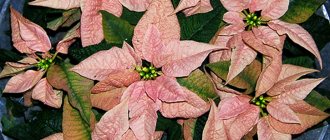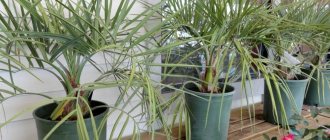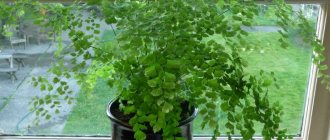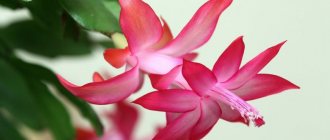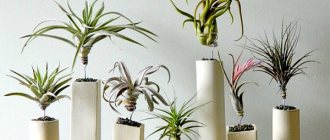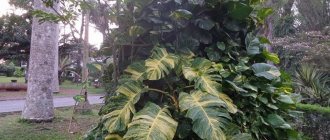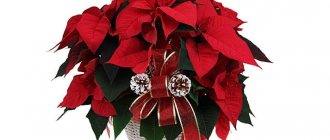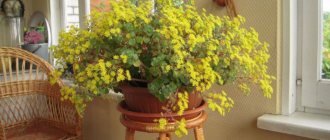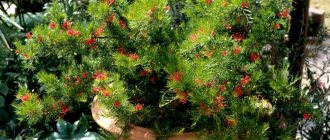Description of poinsettia
In the wild, it is a shrub that reaches 3 meters in height. Belongs to the Euphorbiaceae family, their main distinguishing feature is the release of poisonous milky juice when damaged. In the past, the poisonous milk was used for medicinal purposes and to make some medicines, and the bright leaves were used for dyeing fabrics and for cosmetic purposes! This flower is an evergreen!
Poinsettia
Growing at home, this small bush, about 40 cm high, is a fluffy cap of rich green leaves, jagged at the edges. You can also find a different leaf color - two-color. In this case, the rich green leaves are yellowed towards the edges, as if dried out, but this color does not spoil the appearance at all.
At the top of the cap, yellow rosettes are formed, which are surrounded by red leaves - these are the so-called flowers!
Domestic representatives are usually one-year-old, maximum two-year-old.
The flowering period is very short, from 2 to 6 weeks, falls during the cold period of time, the Christmas holidays! By the end of flowering, the plant sheds all its leaves and becomes completely naked; from this moment it goes into a state of hibernation, but this does not mean that it has died. It is likely that by next winter it will again delight you with its enchanting beauty!
In the wild, a common poinsettia that has a bright fiery color. But time does not stand still and breeders have developed new varieties with different shades.
There are both monochromatic and variegated representatives.
Description and features
Poinsettia is the second official name for Euphorbia pulcherrima (Latin Euphorbia pulcherrima), a popular member of the Euphorbiaceae family. The plant's natural habitat is in the tropical central Americas and Mexico.
Poinsettia flower or Christmas star
Beautiful spurge develops as an evergreen shrub up to three meters high. The ovoid-elliptical dark green serrated leaves of poinsettia, about 15 cm long, are attached to the shoots using petioles.
The yellowish small flowers appear in December and are arranged in rosette-shaped inflorescences. They are surrounded by bracts of expressive rich shades - pink, bright red, scarlet, white, giving the plant incredible charm. There are two-color varieties. Blooming poinsettia pleases with its presence until February.
It should be noted that the juice of this exotic plant can cause redness of the mucous membranes or skin with severe itching. Therefore, pruning and replanting is carried out in closed clothing and gloves. Protect your eyes with goggles and your respiratory organs with a mask. Be sure to take measures to limit access to the flower for pets and especially children.
Varieties and varieties
Variegated
Sonora Marble
Sonora Marble
A creamy beauty with an ivory hue interspersed with a pink tint in the middle.
Winter Blush Marble
Winter Blush Marble
Surprising with the non-standard color scheme of the leaves. The crown has a soft pink color with a milky edging, surrounded by grass-colored leaves.
Strawberry and cream
Strawberry and cream
Unrealistically beautiful “marble” look. An interweaving of soft white spots with a coral tint of foliage.
Da Vinci
Da Vinci
An amazing view, striking in its beauty. Non-standard color scheme in the style of “pink flamingo”.
Monet Twilight
Monet Twilight
The owner of cream flowers with a blurred pink tint, as if stained with scarlet paint.
Tapestry
Tapestry
A chic variety, the characteristic feature of which is the heart-shaped leaves of a deep scarlet color.
Yellow and orange representatives
Lemon snow
Lemon snow
The owner of a pale lemon color.
Cinnamon star
Cinnamon star
Representatives of this variety have tiered leaf color. An amazing combination of orange color, smoothly turning into rich yellow, which turns into leaves with green veins. A distinctive feature of this species is its sharp, jagged leaves.
Orange Poincettias
Orange Poincettias
The elongated leaves of this variety have a rich orange color.
Yellow Poincettias
Yellow Poincettias
Representatives of this species have all shades of pistachio color.
Euphorbia pulcherrima
Euphorbia pulcherrima
The owner of a fiery hue. The color scheme of the leaves smoothly transitions from rich yellow to fiery orange.
Holders of white leaves
White Star
White Star
The name itself speaks for itself! Elongated, pointed leaves of pearl-beige color, collected in a bouquet, look like huge stars!
Polar Bear
Polar Bear
Representatives of this species resemble a piece of iceberg in their color. The core of the flower has a yellow tint with a slight green tint.
Arctic White
Arctic White
Cool white flowers against the backdrop of rich green leaves will not leave anyone indifferent.
All shades of red
Tapestry
Tapestry
An amazing variety that fascinates with its beauty. The flowers are a rich fiery scarlet color, and the leaves that grow along the shoot are two-colored, with a yellow coating on the edges.
Carousel Red
Carousel Red
A very unusual variety! A distinctive feature of which is the openwork edges of the inflorescence of a rich red color, which distinguishes it from the leaves themselves.
Carousel Dark Red
Carousel Dark Red
Very similar to the previous species, especially in the structure and shape of the flower, only the shade is dark scarlet.
Premium Red
Premium Red
This is a classic among all varieties. It is a lush bright red inflorescence in the middle of the crown. The core is standard - yellowish-green.
Cortez Burgundy
Cortez Burgundy
A representative of a rich burgundy shade with a traditional heart-shaped petal shape.
Other varieties
Blue poinsettia
Blue poinsettia
This view has mesmerizing beauty! The flowers are electric blue and are combined with rich green leaves, which are painted with uneven dark veins.
Eckespoint Lilo
Eckespoint Lilo
A very non-standard color scheme for poinsettias. Purple flowers with a lilac sheen.
Polly Pink
Polly Pink
The brightest representative of pink! The leaves are deep pink.
Prestige Maroon
Prestige Maroon
Queen among poinsettias! A rich, noble burgundy wine shade combined with dark emerald leaves gives this variety a regal appearance.
How to choose the right flower when buying
Short daylight hours and lack of sunlight force indoor plants to remain dormant. Poinsettia, a tropical shrub, has retained the characteristic flowering characteristic of its wild relatives in the winter months, appearing in our stores in late autumn, brightening up these gloomy days with exotic splendor.
You can buy a plant only in specialized stores, where the air temperature corresponds to the conditions for keeping this particular species; it must be above 15 degrees, otherwise there is a risk of getting a flower with frostbitten roots, which will eventually become a non-viable plant.
You need to pay attention to some details:
- Lack of packaging (the flower must be clearly visible).
- The potting substrate is moderately moist (excessively wet or dry - evidence of improper care, which can affect the life cycle of the Christmas star).
- Stems - evenly colored, without black or brown spots, firmly rooted with the soil; leaves are present on all sides of the stems, bright green in color, without signs of wilting, disease, or insect damage.
- The bracts are clean, not pollinated by pollen (signs of yellowness and the presence of pollen indicate long-lasting flowering).
- The flowers should be in greenish-yellow buds (the blossoming inflorescences will soon finish flowering).
If the Christmas star corresponds to what is described, you can safely buy; if there are any discrepancies, it is better to refrain and visit another store, otherwise the purchase will turn into a tragedy. Open markets and unheated pavilions do not correspond to the maintenance of potted flowers.
Reference! Despite poinsettia belonging to the poisonous genus of euphorbia, there is no danger to domestic animals. People allergic to latex should be careful; the milky sap of the plant causes skin irritation.
How to care for a Christmas star flower (Poinsettia)
With the onset of cold weather, most flowers usually enter a dormant period, and only a few plants are able to delight the eyes of their owners on frosty winter days with their chic, stunning flowers, bringing a great mood and feeling of summer into the house.
One such type of flower is the Christmas star or Poinsettia.
She is able to appear before us in all her glory in winter, when it is frosty and snowing outside.
If you want a beautiful flower to bloom in your home for Christmas
, resembling a star, then be sure to place Poinsettia on your windowsill.
Caring for this flower may not seem very easy at first, but for people
who have a patient character can handle any difficulties. And for lovers of true beauty who properly care for a flower, surround it with their care and love, carrying out all the necessary procedures on time, it is able to give unusual bright blooms.
*Soil in a pot
should not be dry.
*Note
on the crown of leaves and bracts. They should be fluffy and fresh.
*Plant stems
should be short, the foliage should be bright green.
*Try never to purchase
this flower is outdoors if the air temperature there is less than 5 degrees Celsius. The bush can get sick and die even if it stands outside for a very short time.
*Note
to ensure that the leaves are not covered with pollen. This is a sign that the plant has not yet flowered.
*Try to choose a neat, even bush.
Make sure that the amount of foliage around is the same.
*If the flowers on the plant have a greenish tint
, then most likely the plant is sick. Do not purchase a flower if you see fading flowers or signs of rot on it.
Do I need to move it to another pot after purchase?
There is no need to go through this procedure after purchase. But if you see that the plant is cramped in its previous pot, immediately transplant it into a new one. In places of sale, flowers are often planted in small pots to save space, so the soil is quickly depleted, and the roots lack not only space, but also nutrition.
Another important point is that in the store indoor flowers are sold in pots with transport soil. It is very light, making plants easy to transport. However, flowers do not feel very comfortable in it. This is another reason why purchased flowers need to be replanted.
Stages of flower transplantation
- Pick up a new pot. It should be 2-3 cm larger in diameter than the previous one. There is no need to take containers that are too large - water stagnates in them, which often leads to rotting of the roots.
- Select the soil mixture based on the plant variety.
- Water the plant a day before you plan to transplant it. If you can’t do it in a day, do it at least an hour in advance.
- Make a drainage layer at the bottom of the pot. You can use broken bricks or shards. Place a layer of expanded clay on top. Add sand and a 1-2 cm layer of fresh soil.
- Take the flower pot in your hands, turn it over and lightly tap it on the table, gently holding the plant. If this is problematic, separate the roots from the walls using a sharp knife.
- If there are old shards at the bottom, remove them. Leave some of the soil on the roots so as not to damage them. If some roots are rotten or damaged, cut them off.
- Place the flower on a layer of soil in a new pot, carefully fill the remaining space with fresh soil. To ensure that there are no voids left, after adding another layer of soil, tap the edge of the pot on the table. The stem should be located in the middle.
- Press the soil around the roots with your fingers. Water the plants generously and move them to a sheltered place for a couple of weeks. Spray the leaves every day. After the specified time, the flower can be placed in its original place and cared for as usual.
Flower care after flowering and during the dormant period
Quite often, poinsettias are treated as a disposable plant - after flowering is completed, they are simply thrown away in order to purchase a new one for the next Christmas. This is more typical for residents of Europe and America, however, with proper care, the Christmas star can bloom again at home.
Usually in mid-February, poinsettia finishes flowering and begins to prepare for rest - a dormant period. She warns about this by driving young green leaves over the bracts.
When flowering ends, the bracts wither and fall off, and the poinsettia goes dormant.
Caring for the plant at this time is as follows:
- The stems are cut to about 15 centimeters so that each has 4 or 5 buds. At the same time, the bush is given the desired shape and the degree of density of its crown is adjusted. In the future, it is easy to maintain the given shape by pinching or trimming young shoots.
- The plant is transferred to a cool, dark room with a temperature of 10-12C. Watering is reduced to once every 10-12 days.
- There is no need to feed the flower at this time.
Important! During the hibernation period, it is necessary to ensure that the substrate does not dry out completely.
The dormant period of poinsettia lasts one and a half to two months, after which it is prepared to return to its original habitat.
Is poinsettia poisonous or not?
Poinsettia tissue contains poisonous white milky juice - as does all other members of the family. This juice contains euphorbic acid, euphorbine and cyanogenic compounds, which can painfully burn the skin, cause inflammation, and if it gets into the eyes, even temporarily blind a person.
Poisonous juices are found in the roots, leaves and stems.
It is also worth knowing that the flowering leaves that delight us (those that are so beautifully colored red) owe their color to dyes belonging to anthocyanins.
Poinsettia
All this sounds menacing. And so much so that some believe that the name of the plant comes from the English. the word poison, meaning "poison". But this is just complete nonsense! The name "poinsettia" comes from the Poinsett surname of a man named Joel Roberts, who brought the Star of Bethlehem from Mexico to the United States.
In practice, as it turns out, information about the strong toxic effect and toxicity of poinsettia is greatly exaggerated.
Although Star of Bethlehem may cause gastrointestinal distress, nausea, and vomiting after ingestion, in practice this occurs in less than 10% of human consumption of the plant. The discomfort is usually very mild and rare.
However, if a poinsettia flower appears in the house, it should be installed in a place inaccessible to small children, and when caring for the plant, avoid direct contact with juices that may leak, for example, when a branch is broken. But there is no need to exaggerate. A huge number of indoor plants grown in our apartments can be much more poisonous than the Star of Bethlehem.
Reproduction
Most often, the plant is purchased at the store, but you can try to grow it yourself. Poinsettia seeds develop only in the wild, so the cutting method is used for propagation.
Before planting, it is necessary to lower the cuttings into water to allow the milky juice to drain. As soon as this happens, the future sprout is immersed in a special solution that promotes the rapid formation of roots.
After this, the cuttings are planted in the ground, deepening it just a couple of centimeters. For normal establishment, the future plant requires a temperature of 25-28 degrees and constant spraying. The result of the housewife’s efforts will be noticeable in about a month. By this point, the sprout should be completely rooted.
Flowers on such a self-grown plant will appear only after a year.
As the poinsettia photo shows, the flower perfectly helps to create an unusual design, elegantly decorating any room and helping to create a joyful mood.
How to care (briefly)
- Bloom. This culture blooms on Christmas and New Year's Eve.
- Illumination. Bright but diffused light is required (windows facing east or west).
- Temperature. During active growth and development - from 18 to 25 degrees, during the flowering period - from 14 to 16 degrees, during dormancy - from 12 to 14 degrees.
- Watering. In the summer, the bushes are watered abundantly and systematically, and in the winter, the soil should be slightly moist.
- Air humidity. During the flowering period, the bushes need to be systematically moistened with lukewarm water from a sprayer.
- Fertilizer. Feed the plant in spring, summer and autumn 2 times a month with complex mineral fertilizer. When the bushes bloom, you will need a fertilizer containing a large amount of potassium.
- Trimming. Twice a year: in April the bush is shortened to 15 centimeters, and after replanting the plant is shaped.
- Rest period. In March or April for 6-7 weeks.
- Transfer. Regularly once a year at the end of the rest period.
Christmas star - description and origin
Poinsettia is a perennial evergreen shrub that in its natural habitat reaches a height of two to three meters. It belongs to the Euphorbiaceae family. The main advantage is its high decorativeness, which is associated with its botanical name - beautiful spurge.
The oblong leaves are oval-shaped, wedge-shaped at the base, usually up to 15 centimeters long. The apical leaves have a pointed, notched-lobed shape and are dark green.
Rosettes of small yellowish-white flowers are surrounded by brightly colored bracts. The color of the bracts is most often red, although breeders have obtained varieties of white, yellow, and purple colors. It is the bracts with lanceolate leaves that perform the decorative function of poinsettia.
The Christmas star blooms in the winter months - December-January, which, in fact, became the main reason for the second name of the plant.
At home, poinsettia grows up to 50 centimeters in height without losing its high decorative qualities.
The birthplace of poinsettia is the countries of Central America, their shady mountain slopes. The Aztecs were the first to appreciate its benefits, using the plant for practical purposes. They used the brightly colored stipules to dye fabrics and used them in the production of cosmetics. They successfully treated fever with white milky juice.
From Mexico, poinsettia first came to the USA, in 1828, to greenhouses and botanical gardens. It was from the USA, where it became a flower symbolizing Christmas and a product of commercial activity, that two years later the magnificent plant arrived in Europe, where it also spread as a Christmas decoration.
And it was in Europe that it got its name - poinsettia, in honor of the American botanist, doctor J. Poinsett. Before this, its name was unpronounceable - cuetlaxochitl.
In Russia, poinsettia gained popularity at the turn of the 20th and 21st centuries, also as an interior decoration for the New Year and Christmas.
Caring for poinsettia at home
It is recommended to grow beautiful euphorbia on windows of eastern or western orientation. It should be borne in mind that such a flower reacts extremely negatively to drafts and direct sunlight. During active growth of the bush, the temperature in the room should be from 18 to 25 degrees, during the flowering period - from 14 to 16 degrees, and during dormancy - from 12 to 14 degrees.
Temperature
Exotic indoor poinsettia requires special conditions for normal growth and beautiful flowering. Taking care of her in a city apartment is quite difficult. The plant loves humidity and is very picky about temperature conditions. The ideal temperature for a Christmas flower is 12-25˚C. He does not like drafts and cold. Also has a negative attitude towards summer heat.
It is necessary to strictly ensure that poinsettia leaves do not touch the cold glass of the window in winter. And a heating radiator so that the air around it does not dry out.
Lighting
The flower does not like to be exposed to direct sunlight, preferring bright but diffused light. If poinsettia has settled in your house, then try to place it in the illuminated areas of the loggia or garden in the summer, but at the same time avoid direct sunlight on the leaves.
If this is not possible, provide her with fresh air through ventilation, but without drafts. In order for a plant to bloom for the New Year, it requires a special light regime. The flower should be exposed to light no more than 13 hours a day, so the bush should be covered with a dark bag at dusk; light should not penetrate its surface. You can put it in a dark room and put it back in its original place only in the morning.
Such actions are necessary within 2 months; the “shortened day” tactic helps the plant form inflorescence buds and bloom before the New Year. After bright bracts have appeared, you can switch to normal light mode.
Lighting for poinsettias
Watering
Poinsettia should be watered regularly in spring-summer-autumn with soft, settled water at room temperature. It is necessary that the water moistens the entire earthen lump in the pot. Drain excess water from the pan about twenty minutes after watering.
Do the next watering no earlier than the top layer of soil from the previous watering has dried out. But do not allow the soil in the pot to dry out completely - you will lose all the leaves. If you see that the leaves of your poinsettia begin to wilt between waterings, immediately water it with a small amount of water.
And then water as usual, at the appropriate time - perhaps the break between waterings was too long, or the room was too hot and dry. In summer, it is better to water the flower more often, but moderately, so that the water does not linger in the soil for a long time. During flowering, in winter, it is important to water the poinsettia with warm water, the temperature of which is a couple of degrees higher than the air temperature in the room. Otherwise, the flower may shed its beautiful leaves.
Top dressing
Feeding the Christmas star is usually done in the spring, when the plant has finished its dormant period or about a month after you transplanted it into new soil. Feed the flower once every three weeks. It is best to use granular or complex liquid fertilizers. Fertilizers should be applied until autumn.
At the beginning of autumn, when the flower is preparing to bloom, phosphorus and potassium salts should be added. It must be remembered that the Christmas star should not be fed with fertilizers during flowering and for some time after it, as well as during the dormant period of the flower.
What to do after purchase?
After moving to a new location, poinsettias will need 20 days to acclimatize. It is necessary to care for the flower during this period with special care. First of all, you will have to ensure optimal humidity and temperature.
Blooming poinsettia feels great on a well-lit, draft-free windowsill. In this case, you need to make sure that the leaves do not come into contact with the cold glass, otherwise the flower will drop them. The optimal temperature for milkweed during the adaptation period is 18-20°C. The lighting should be bright, but diffused. In order for the plant to bloom longer, it needs to be illuminated in the evening for 1-2 hours.
The soil under the bush should be constantly moist. In the first 2-3 days after purchase, you don’t have to water the spurge. Then moisturize every 3 days with warm filtered water. To be sure that the plant needs watering, you need to press the earthen ball under it with your finger to a depth of 2 cm. If the soil is moist, watering is not needed. Dry - water until water appears in the pan. After 30 minutes, the water is removed from the pan.
In the room where the Christmas star pot is located, moderate humidity should be maintained (within 50-55%). If the air is too dry, it is advisable to cover the radiators with a wet cloth, place stones or gravel moistened with water in the tray with the flower, and place a jar of water or an aquarium next to the pot.
It is useful to periodically spray the leaves in the morning, making sure that drops of water do not fall on the bracts.
After 3 weeks, the poinsettia is transplanted into a new (preferably ceramic or clay) pot. This is done like this:
- The soil under the bush is thoroughly moistened.
- Drainage is poured into an empty pot of the same or slightly larger volume, and then a slightly acidic soil mixture of the following composition:
– 3 parts each of turf soil and leaf humus;
– 1 part each of peat and river sand.
The milkweed is transferred to a new container along with a lump of earth. The voids in the pot are filled with soil.
Adult specimens are often not replanted
Since it is not always possible to create optimal conditions for the growth of an exotic flower, novice gardeners prefer to buy poinsettia annually in December, and when the bright bracts fly off, throw the plant away. If you want to experiment and test your skills, you should study the information below about the conditions of detention.
Poinsettia in autumn
Proper care of the wonderful flower called the Christmas star in the fall is important if you want to see it bloom just in time for the merry New Year holidays.
The difficulty is that poinsettia under natural conditions begins to bloom after the time of year with the shortest daylight hours. It lasts for about two months.
The plant should be illuminated 9-10 hours a day.
At the end of September, to simulate such conditions, the pot is placed in a non-residential building, where artificial light is not turned on in the evening and in the morning. If there is no such place in the apartment, then the flower will have to be hidden under an opaque box or film from evening until morning.
During this period, the plant should be watered regularly, as soon as the soil in the pot is half dry. Once every 7-10 days the plant needs to be fed with a composition for flowering plants.
Poinsettia in winter
In the first ten days of December, when your flower has already lived for two months with shortened daylight hours, you can stop tormenting it. Poinsettia is placed on a windowsill in a bright, warm room.
After some time, provided that you have taken proper and regular care of the amazingly beautiful Christmas star, buds and then flowers will appear on the green branches.
An indoor poinsettia flower is often given as a gift during the winter months on the occasion of a birthday or New Year. Therefore, winter is the season when the plant most often first appears in the house. Start caring for your Christmas star correctly from the first days so that you don’t have to throw it away at the end of the holidays.
Try not to open a window or window in the place where the poinsettia is located. This tropical beauty will not survive the cold. She is also afraid of drafts.
Water the plant deeply and regularly. But, make sure that liquid does not accumulate in the pan.
An important condition for proper care of the delicate and capricious Christmas star is air humidity. Spray it 2 times a day with clean warm water or install a humidifier in the room.
Continue feeding with flowering fertilizer. Has a newly purchased flower appeared in the house? Apply fertilizer no earlier than every month.
In flower shops, to maintain the presentation of plants, they are sometimes fed too intensively.
Rules of care
Like any ornamental plant, poinsettias also need care for normal functioning. After all, timely watering, correct location, good soil are all elements of care that affect the appearance of any plant.
Since the flower is of tropical origin, it prefers high air humidity. Particular attention should be paid to this issue in winter, when heating devices work intensively and during the sultry heat in summer.
Spraying the air around the plant, but avoiding getting it on the flower itself, will help you cope with this nuance without difficulty.
Another alternative option to solve the problem with air humidity is to place a container of water near the poinsettia. This will allow you to maintain the required humidity balance.
Interesting video about the secrets of caring for a flower:
The Christmas star is a very unusual flower! Don't forget that this beauty is also poisonous! And the greatest amount of poison is concentrated in its beauty - the so-called flowers! But despite this, it will perfectly complement your interior with beauty and bring some zest to it!
If you find an error, please select a piece of text and press Ctrl+Enter.
Source
Poinsettia in spring
With the onset of warm spring days, poinsettia ends its flowering. The bracts are falling and the leaves are starting to fall. This means that the plant is entering a dormant phase.
Trim the Christmas star flower. It is better to leave shoots only 7-10 centimeters high in the pots. Place it in a shaded area. It is desirable that during the resting phase the air temperature in the room should be within 12-15˚C.
Water infrequently. It is necessary to allow the earthen coma to dry out completely between waterings.
Such conditions for caring for poinsettia flowers must be observed for one and a half to two months.
Can the Christmas star flower be poisonous?
There is still a slight threat to the juice of this plant.
If it gets on the skin, dermatitis may occur in that group of people who are intolerant to the milky sap of similar plants.
If you belong to this category of people, then when working with a flower, just wear gloves and wash your hands very thoroughly
after working with the plant.
Scientists have officially proven
the harmlessness of the Christmas star for animals and humans.
At first glance, caring for a Christmas star flower may not seem very easy.
, and the plant itself is too capricious, but you must agree that it’s nice to receive a New Year’s gift in the form of a gorgeous, bright flower, knowing that it was you who grew it with a certain amount of love and care.
Source
Poinsettia in summer
From the end of May, the indoor poinsettia flower enters the stage of active growth. At the beginning of this period, the plant can be replanted.
Caring for a flower with such a beautiful name - Christmas star - implies:
- good lighting;
- moderate watering;
- temperature range 15-25˚С;
- fertilizing with humus or universal fertilizer.
With the onset of stable heat, the plant can be taken out to the balcony (garden).
As soon as the active growth of shoots begins, you need to begin to form a bush. Cut poinsettia branches can be used for propagation by cuttings.
Propagation of poinsettia by cuttings
Most often, flower growers use the possibility of vegetative propagation. Best of all, cuttings 10 to 15 cm long, obtained after trimming the poinsettia, take root at home in spring and early summer.
Since the plant secretes milky sap, which interferes not only with the drying of the cut, but also with root formation, before planting pieces of stems in the ground:
- their lower leaves are cut off;
- The cut sites are immersed in water for several minutes;
- then blot with a paper napkin;
- The tips of the stems are sprinkled with a root formation stimulator.
Now the cuttings intended for poinsettia propagation are ready for planting. As a substrate, you can use a light, breathable mixture of washed sand and perlite. The root system of young plants is not too large, so first and before transplanting the poinsettia to a permanent place of residence, you can use very small pots or cups with a capacity of up to 250 ml.
A drainage hole is made at the bottom of the container. The cuttings are immersed in the soil to a depth of 3 cm, this is enough. The seedlings are placed in an indoor greenhouse.
Propagation of poinsettia by cuttings
Next, young poinsettias need:
- watering as needed;
- bright, but not direct light;
- constant temperature within 16–22 °C;
- regular ventilation.
This care is enough for the tops of the stems to sprout roots in 45–60 days and be ready to be transferred to permanent pots. To transplant poinsettias, take containers with a diameter of 7–10 cm, at the bottom of which a layer of drainage is made, and then filled with a substrate based on leaf and turf soil with the inclusion of a small amount of peat, cleared of foreign inclusions, and sand.
With the beginning of active growth, the top of the seedling is removed. This type of pruning of poinsettia at home allows you to immediately get a branching bush with several bright inflorescences.
Poinsettias that have already bloomed in the previous season are replanted in a similar manner. The procedure is carried out in the second half of spring after pruning the houseplant.
Poinsettia - propagation
Usually, a Christmas star, which has been cared for according to all the rules, produces a large number of cuttings at the beginning of summer. Of these, you should choose those that have reached at least seven centimeters in length and have at least five leaves. Suitable shoots need to be trimmed below the bottom node, and then excess lower leaves should be removed from them.
Next, the cutting is placed in warm water for ten minutes in order to eliminate excess juice, after which it is planted in moist soil, which has the same composition as for replanting the plant.
Pots with shoots are placed in a warm, sufficiently lit place and covered with polyethylene to create a kind of greenhouse. Periodically, the plant is sprayed and ventilated. After about a month, the cuttings should take root well, then they are pinched. This is necessary in order for new stems to form and a lush bush to form.
Poinsettia propagation by seeds
Few people know that pruning is not so necessary to propagate poinsettia at home. By pollinating the tiny flowers yourself, you can wait until round, almost black seeds form and ripen.
It is more convenient to transfer pollen using a cotton swab or a thin soft brush. At the same time, it is important to touch each flower and make sure that the grains get where they need to be.
Poinsettia propagation by seeds
After some time, greenish seed pods appear in place of the flowers, resembling small bulbs in appearance.
When the foliage begins to fall, the boxes are collected and stored in a paper bag without access to moisture. The dried, brown boxes open easily, and the ripened seeds roll out.
To encourage the formation of sprouts, poinsettia seeds, laid out on moist soil and lightly sprinkled with soil, are placed in a household refrigerator for three months for stratification.
Germination begins in warm conditions and takes several weeks. All this time, the crops should be moderately moistened. Mold or rot should not be allowed to appear, so the greenhouse must be ventilated regularly.
Caring for seedlings is not much different from other domestic crops. Small plants are first picked, and then, when they become stronger, the poinsettias are transplanted into spacious pots.
How does the Christmas star reproduce?
Propagation occurs using cuttings that remain after pruning. Root them by placing them in damp peat or moss. It is better to cover the cuttings with a glass jar to ensure increased humidity and favorable temperatures.
By the way, look at the previous article. There is a lot of useful information for you - How to care for cyclamen at home?
After the roots appear, the young plants are transplanted into the ground.
Diseases and pests
Leaves and inflorescences may begin to lose color, fade, and fall off. This means that you have over-moistened the soil, or placed the pot with the plant in a draft, or the plant does not have enough lighting.
If the leaves turn brown and the flowers fall off, the flower is too hot and dry.
Most often, poinsettia suffers from attacks by thrips, spider mites and mealybugs.
If there are wavy oblong spots on the leaves, or the leaves begin to curl, then these are thrips.
The scale insects cause the leaves to become covered with honeydew (a sticky, drop-like secretion).
If the leaves begin to rapidly turn yellow and dry out, this is a spider mite.
Wipe the plant with soapy water and rinse under a warm shower (but do not over-wet the soil). Treat with pest repellents.
Possible diseases and methods of treating them
The list of measures for caring for a magnificent poinsettia includes ways to combat certain diseases and pests:
- If you notice brown shoots indicating the development of fusarium, you should treat them with Fitosporin.
- For powdery mildew, which manifests itself as a whitish, loose coating, use the fungicide Topaz or Skor.
- Gray rot, which appears due to excessive waterlogging of the soil substrate, gradually affects all parts of the plant. To combat this disease, the fungicide Fundazol is used.
- The presence of spider mites can be detected by examining the underside of leaf blades by looking at the light whitish web. You need to wipe all the leaves with warm water. Actofit and Fitoverm are used for irrigation.
- When damaged by thrips, oblong marks with wavy edges are noticeable on the leaves. The insecticide Aktara is used for control.
To prevent disease outbreaks and minimize the presence of harmful insects, you need to follow the watering schedule and maintain optimal humidity.
The magical properties of poinsettia
How Poinsettia affects people:
- helps revive marital love, makes relationships passionate and bright;
- helps to replenish the family: it is recommended to keep it for spouses who are unable to have a child;
- gives pure energy of joy, helps drive away depression, despondency and blues, it has the power to maintain a good mood, create a warm atmosphere, attract new opportunities for positive emotions;
- improves the well-being of the inhabitants of the house, increases enthusiasm and vitality (it will help a sick person to recover faster);
- attracts well-being and prosperity - in the spiritual and material aspects;
- helps to assimilate knowledge, concentrate, think creatively and generate new ideas - a person thinks faster, is less tired of intellectual work, works efficiently and with pleasure.
In addition, the flower protects from negative energy: the evil eye, damage, external bad influence, internal conflicts and fears. Only pleasant and friendly people come to the house where poinsettia grows, but those who are hostile here become uncomfortable. The atmosphere in the family becomes warm and friendly, and the financial situation stabilizes.
Poinsettia: signs and superstitions
Blooming luxuriantly at Christmas, poinsettia has healing powers and brings good luck. It should be placed in the center of the Christmas table - then those present will be healthy, joyful and rich all year long.
Natural poinsettia has bright red bracts - it attracts well-being, prosperity, good mood and pleasant guests to the house, and helps children study better. Today, breeders are developing varieties of a wide variety of colors and shades. The palette also affects the energy: soft pink, peach and creamy yellow varieties have less pronounced fire energy, and blue and purple varieties have an element of the water element.
Poinsettia Sonora White glitter
Other beliefs:
- If a cat gets into the habit of eating this flower, it is in the wrong place. Judging by the sign, another part of the house needs his positive influence - rearrange the flowerpot until the animal loses interest in it. But at the same time, follow the rules of maintenance - plenty of light and no drafts.
- Leaves on the plant suddenly fall off - this means that one of the family members is ill. This is often due to lack of care - eliminate mistakes and take care of the flower correctly. While recovering, he will restore favorable energy. However, if abscission occurs naturally (after flowering on the eve of the dormant period), this superstition is not relevant.
- If, during pruning, milky juice splashes directly into the face, the omen speaks of a dangerous ill-wisher. He spreads bad rumors, weaves intrigues and tries to harm you. Use cut cuttings to propagate the plant - this way you will strengthen protection and improve the quality of life, despite the machinations of enemies.
- A gift of poinsettia strengthens relationships between people, making them joyful, selfless, loving and faithful.
Feng Shui
Poinsettia in the interior
Bright red poinsettia activates fiery energy and speeds up all processes. It can be kept in your personal account to generate new ideas, increase income, and improve communication skills. In the marital bedroom, she will add passion to intimate relationships. In the kitchen or dining room, a flower will bring special benefits: it will make family feasts fun and enjoyable, attract prosperity, improve the taste and energy of food, increase metabolism in the body and help lose weight.
Feng Shui masters say that the living room is a universal place for poinsettias. Here it performs the main functions: creates a favorable atmosphere, establishes mutual understanding between family members, and produces the energy of joy.
If there is already too much “fire” in your house (bustle, guests, excitement, rush, constantly changing events, etc.) - opt for a decorative variety with a different shade of bracts: pink, peach, creamy yellow, orange.
If you strive for spiritual growth, get a purple variety, and if you want clarity of thinking and serenity, get a blue one.
Is it possible to keep poinsettia at home?
This is a very beautiful flower with gorgeous blooms and great energy. You can and should keep it at home, but you need to remember some features. This plant belongs to the euphorbia species, the milky juice of which is poisonous (although in this case less so than that of other varieties). If it gets into the stomach, it can cause poisoning, irritation on the skin, and burns on the mucous membrane.
Therefore, you should not have it in a house where there are small children, and as for pets, they have a good sense of smell and avoid dangerous vegetation. Some cats still eat poinsettia and, judging by the reviews of their owners, without visible harm. However, it is better to place the flowerpot away from those who want to chew the leaves. Even if the cats are not harmed, the damaged plant may refuse to bloom.
It is better to carry out pruning, replanting and cuttings with gloves and careful attention so that the juice does not splash into your eyes (to be on the safe side, you can wear safety glasses). Energy and care Only a healthy and flowering plant has positive energy.
In poor conditions and without proper care, it will begin to broadcast not benign “emotions”. Therefore, it is worth starting it only in those houses where it will be properly looked after.
There are a few important rules to remember:
- Do not overwater the flower - like all euphorbias, it does not tolerate waterlogging;
- To keep the bracts bright, fertilize them with a special composition;
- After flowering, when the leaves fall, prepare the plant for the dormant period: cut the stems, stop feeding and reduce watering;
- Starting from October, organize a “short day” regime for two months: at about 17-00, cover the flower with a dark bag and transfer it to the closet, and early in the morning put it on the windowsill - this will stimulate the formation of buds and beautiful “stars” will appear just in time for the winter holidays.
Sources and literature
Sources and literature
- Bernardino de Sahagun, Kuprienko S.A. General history of the affairs of New Spain. Books X-XI: Knowledge of the Astecs in medicine and botany / Ed. and lane S. A. Kuprienko.. - K.: Vidavets Kuprienko S. A., 2013. - 218 p.
- Beketov A. N. Dicotyledons // Encyclopedic Dictionary of Brockhaus and Efron: in 86 volumes (82 volumes and 4 additional). - St. Petersburg, 1890-1907.
- Paul E.Ranch “The Poinsettia and its legend”, Chicago, 2001
- Klug, S., Saleem, G., Hocharuk, L., Marcus, S. Toxicity potential of poinsettia, is the plant really toxic? Ottawa, 1990.
- Taylor, Judith M.; Lopez, Roberto G.; Currey, Christopher J.; Jan, Jules. The Poinsettia: History and Transformation // Chronica Horticulturae. - 2011. - T. 51, No. 3. - P. 23-27.
